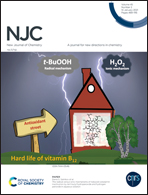Mononuclear and dinuclear gold(i) complexes with a caffeine-based di(N-heterocyclic carbene) ligand: synthesis, reactivity and structural DFT analysis†
Abstract
Two new gold(I) complexes with a di(N-heterocyclic carbene) ligand (diNHC) derived from caffeine have been synthesised by a base-assisted metalation of the appropriate di(azolium) salt in the presence of the gold precursor AuCl(SMe2). Under kinetically controlled conditions, the reaction affords a mononuclear cationic complex with the diNHC ligand chelating the gold centre, while the thermodynamically more stable complex is a dinuclear species with two bridging diNHC ligands. The two complexes have been characterised in solution by mass spectrometry, and 1H, 13C and DOSY NMR spectroscopies; the mononuclear–dinuclear transformation has been also followed with kinetic experiments giving a second-order rate constant k = (1.46 ± 0.01) × 10−2 dm3 mol−1 s−1 in CD3CN, at 313 K. Density functional theory (DFT) calculations have been performed to support these findings. The reactivity of the gold(I) complexes has been evaluated in the oxidative addition of halogens. The reaction allows accessing the corresponding mono- and dinuclear gold(III) complexes, which are stable and do not interconvert. With the mononuclear complex, species of general formula [AuX2(diNHC)](BF4) (X = Cl and I) have been isolated and a systematic structural investigation of the possible isomers has been performed through DFT calculations.



 Please wait while we load your content...
Please wait while we load your content...